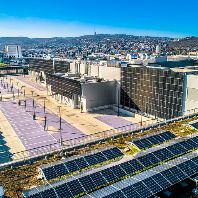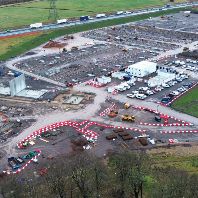Friday, 10 April 2015
Central Europe received €1.3 bln in investments in Q1 (EU)

Central European markets of Poland, Czech, Slovakia, Hungary and Romania saw €1.3 bln in investments in Q1, almost identical to the transaction volume in Q1 2014. However, investors’ appetite and strong activity highlight growing investment volumes for the year ahead exceeding 2014 levels.
Retail was the leading sector in Central Europe with €762 mln traded in Q1 2015 (a 66% increase year-on-year), followed by the industrial sector continuing its impressive growth with €382 mln (a 200% increase year-on-year). Offices attracted only €147 mln investment capital (an 80% fall year-on-year).
The Czech Republic delivered an exceptional Q1 performance with €800 mln transacted (a 228% increase year-on-year) primarily in the retail and industrial sectors. The Czech Republic recorded the largest ever property transaction – Union Investment’s acquisition of a majority share in the Palladium shopping center in Prague for circa €570 mln. The investment volume in Hungary was at €44 mln in Q1 2015. Investor interest is returning to Budapest, and an upswing in buying activity across all commercial sectors is forecast in 2015. Romania saw €29 mln transacted.
With 12 transactions recorded in Q1 Poland saw the highest investment activity in the region, but due to a moderate average deal size the volume was at €430 mln, down by 52% year-on-year. However, this excludes the acquisition of a majority stake in the multi-sector ECHO Investment’s platform. The largest single asset transaction was Griffin Real Estate’s acquisition of Green Horizon in Lodz for ca. €65 mln.
Moving East There is a major trend in Europe of capital moving east from the UK, France and Germany to the notable benefit of Central Europe. This is a combination of push factors: extreme pricing, limited availability of quality stock and in some cases, weaker occupational markets; but also strong pull factors: exceptional GDP and consumer spending growth, record occupational take-up figures and the opportunity to acquire best-in-class assets at a discount to western Europe. There are also new occupational demand drivers such as the emergence of CE as a tech-hub.
There is more money focusing on Central Europe than at any time in the past 7 years. We are seeing new key sources of core capital from across Europe starting to replace the recent dominance of North American capital. This is maintaining the downward pressure on yields in Warsaw, Prague and Polish regional cities. Value-add and opportunistic capital is now reaching into development opportunities and standing investments in Hungary and Romania in search of returns. This trend is expected to continue throughout 2015 and 2016.
Source: Cushman & Wakefield
Retail was the leading sector in Central Europe with €762 mln traded in Q1 2015 (a 66% increase year-on-year), followed by the industrial sector continuing its impressive growth with €382 mln (a 200% increase year-on-year). Offices attracted only €147 mln investment capital (an 80% fall year-on-year).
The Czech Republic delivered an exceptional Q1 performance with €800 mln transacted (a 228% increase year-on-year) primarily in the retail and industrial sectors. The Czech Republic recorded the largest ever property transaction – Union Investment’s acquisition of a majority share in the Palladium shopping center in Prague for circa €570 mln. The investment volume in Hungary was at €44 mln in Q1 2015. Investor interest is returning to Budapest, and an upswing in buying activity across all commercial sectors is forecast in 2015. Romania saw €29 mln transacted.
With 12 transactions recorded in Q1 Poland saw the highest investment activity in the region, but due to a moderate average deal size the volume was at €430 mln, down by 52% year-on-year. However, this excludes the acquisition of a majority stake in the multi-sector ECHO Investment’s platform. The largest single asset transaction was Griffin Real Estate’s acquisition of Green Horizon in Lodz for ca. €65 mln.
Moving East There is a major trend in Europe of capital moving east from the UK, France and Germany to the notable benefit of Central Europe. This is a combination of push factors: extreme pricing, limited availability of quality stock and in some cases, weaker occupational markets; but also strong pull factors: exceptional GDP and consumer spending growth, record occupational take-up figures and the opportunity to acquire best-in-class assets at a discount to western Europe. There are also new occupational demand drivers such as the emergence of CE as a tech-hub.
There is more money focusing on Central Europe than at any time in the past 7 years. We are seeing new key sources of core capital from across Europe starting to replace the recent dominance of North American capital. This is maintaining the downward pressure on yields in Warsaw, Prague and Polish regional cities. Value-add and opportunistic capital is now reaching into development opportunities and standing investments in Hungary and Romania in search of returns. This trend is expected to continue throughout 2015 and 2016.
Source: Cushman & Wakefield














